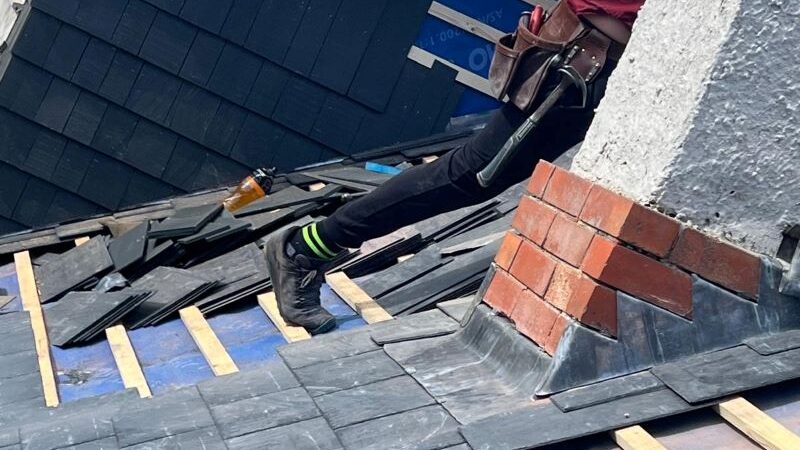Enhance Your Slate Roof's Lifespan Through Quality Flashing to Prevent Costly Water Damage
Flashing serves as an essential barrier located at the most susceptible areas of your roof, particularly where tiles intersect with walls, chimneys, or valleys. Inadequate or poorly installed flashing can lead to leaks, even in the highest quality slate roof, resulting in substantial repair costs over time. Lead is commonly used for flashing in slate roofing due to its remarkable flexibility, long-lasting durability, and ability to adapt to the natural movements of the roof structure. This ensures a tight seal that effectively keeps water out, safeguarding your investment.

Understanding Flashing: Its Importance and Role in Protecting Your Slate Roof
Flashing is the essential material used to seal joints and edges around various structures such as chimneys, skylights, roof valleys, and any point where your slate roof meets a wall or changes direction. These joints are particularly susceptible to water ingress, and without effective flashing, they can become the first areas to fail, leading to leaks. In contemporary construction practices, flashing is often made from sheet metals, yet for traditional applications on slate roofs, lead remains the superior material choice.
Why opt for lead? This unique material not only effectively seals but also conforms to create a robust barrier against various curves, slopes, and edges. It expands and contracts with temperature fluctuations, eliminating the risk of cracking or splitting. Unlike synthetic alternatives, lead does not corrode and maintains its structural integrity significantly longer, often outlasting the slate tiles themselves.
Understanding the Consequences of Flashing Failure on Your Slate Roof
Even the tiniest tear or gap in your flashing can lead to severe leaks. These leaks are rarely straightforward; water can seep beneath the tiles, reach the underlay, and gradually cause problems such as rot, mold growth, or damage to your interior ceilings. The effects of flashing failure may not be immediately visible, often taking years to appear, at which point repairs can become extensive and costly. Issues related to flashing are frequent culprits behind hidden roof failures.
If you observe stains on your ceiling, bubbling paint near a chimney, or patches of moss forming in specific areas of your roof, deteriorating flashing might be the underlying issue.
The Timeless Advantage of Using Lead for Flashing Materials in Slate Roofing
For centuries, lead has stood out as the preferred material for slate roofs due to its exceptional properties. It is recyclable, incredibly durable, and can resist severe weather conditions, whether faced with intense heat or harsh storms. The softness of lead allows it to fit snugly without risking damage to the delicate slate, which is considerably more fragile than lead.
Common applications for lead flashing include:
- Chimney flashings (both step and apron)
- Roof valleys
- Secret gutters
- Roof-to-wall junctions
- Ridge and hip intersections
- Skylight surrounds
These areas endure movement, pressure, and significant water runoff, making them vulnerable to failure when using inflexible materials that may crack or dislodge over time.
Identifying When to Replace or Repair Your Lead Flashing
While lead flashing is generally long-lasting, it will eventually deteriorate. You should consider replacement if:
- The lead has developed noticeable splits or cracks
- It is lifting or curling away from the roofline
- Rust is evident, particularly where lead meets other metals
- Visible water stains are present inside your home
- You are already planning a slate roof repair or rebuild
Most slate roof restorations include a thorough inspection of all leadwork. If we are already on your roof for tile replacement or cleaning, it is the perfect opportunity to evaluate and replace flashing as needed.
The Importance of Skilled Craftspeople in Leadwork Installation
Leadwork is a specialized craft that should not be left to just any general roofer or handyman. Improperly installed lead can sag, split, or detach from the slate, negating the advantages of a well-constructed slate roof. Our team utilizes traditional techniques for installing lead flashing, ensuring correct sizing, appropriate lap joints, and expansion joints that accommodate the typical weather fluctuations in Sydney. We are committed to using lead only where it is the most suitable material for the task at hand.
How Quality Flashing Can Prevent Future Roofing Issues and Save You Money
A slate roof can last for over a century, but only if its most vulnerable points are sufficiently protected. Flashing and leadwork may not be the most glamorous aspects of a roof, yet they are crucial components that endure the brunt of severe weather conditions. If you notice leaks, streaks, or signs of wear around your chimney or roof edges, it is essential to have it evaluated without delay. Replacing flashing now can save you from incurring much higher repair costs for structural damage down the line.
Is It Time for a Professional Inspection of Your Leadwork?
If your slate roof features flashing that has seen better days or shows signs of wear, it is wise to have it examined before minor issues escalate into expensive damage. Reach out to us today to schedule an inspection with a team that specializes in slate, lead, and the intricate details that effectively secure your roof and protect your home.
Your Top Questions Answered: Flashing and Leadwork Explained
What is flashing on a slate roof and its significance?
Flashing is the material used to seal joints and transitions in the roofing system—such as around chimneys, valleys, and skylights—acting as a barrier to prevent water from infiltrating the roofing structure.
What makes lead the preferred choice for slate roof flashing?
Lead is flexible, extremely durable, and resistant to varying weather conditions. It adapts to the shapes of slate tiles and outlasts synthetic alternatives, making it the ideal solution for effective roofing.
How long can you expect lead flashing to last under normal conditions?
With proper installation, lead flashing can endure for 50 years or longer, frequently outliving the slate roof it protects.
Can flashing be repaired without needing to replace the entire roof?
Absolutely, damaged or worn flashing can often be repaired or replaced without necessitating a full slate roof replacement, as long as the issues are addressed in a timely manner.
What are the signs that indicate flashing failure?
Indicators of flashing problems include water stains near chimneys, damage to ceilings, moss growth in isolated areas, or visible gaps where roof surfaces meet.
Do all slate roofs require lead flashing?
Most slate roofs do require flashing. Areas such as chimneys, valleys, and wall junctions need flashing, with lead being the preferred material due to its compatibility with slate.
Is it safe to use lead flashing in residential properties?
Yes, when installed by professionals, lead flashing poses no safety risks. It remains the most effective and traditional choice for slate roofs.
The Article: Leadwork and Flashing: Why It’s Crucial for a Slate Roof first appeared on https://writebuff.com
The Article Leadwork and Flashing: The Importance for Slate Roofs Was Found On https://limitsofstrategy.com

